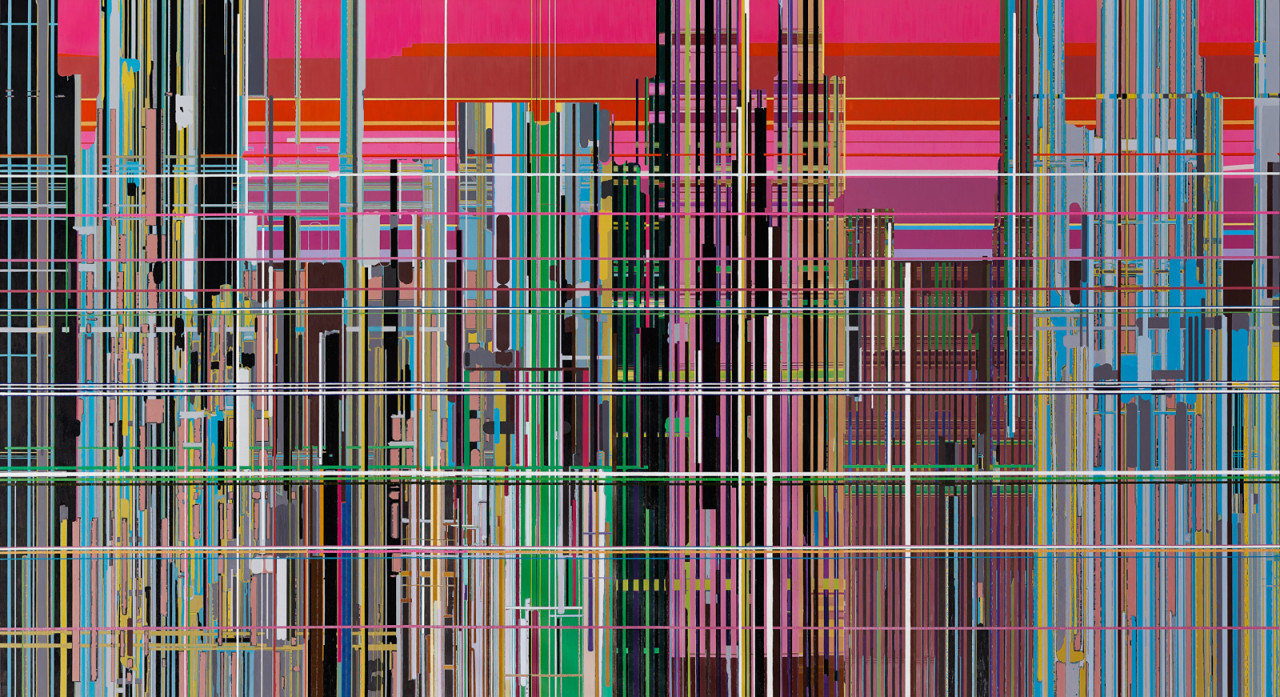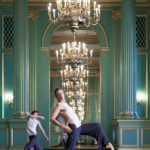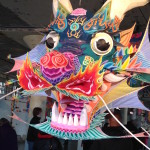28 Chinese summered at the Asian Art Museum in San Francisco, and it was hard to imagine a more riveting setting for this contemporary art exhibit, culled from the permanent collection of Miami collectors Mera and Don Rubell.

Liberation No. 1 (2013) by Liu Wei (b. 1972). Oil on canvas. Courtesy of Rubell Family Collection, Miami. © Liu Wei
A smattering of abstract paintings lined the pristine white walls of the ground floor Osher gallery, while other paintings, sculptures and installations appeared to have parachuted, to spectacular effect, into the byzantine nooks and crannies of the museum (once home to the city’s public library), alighting amid clusters of ancient jade and earthenware, elaborately carved Buddhas, samurai swords and Malaysian kris.
There was a delicious Alice-in-Wonderland quality to some of the galleries.
Ballet to the People nearly tripped over the life-like figure of celebrity artist Ai Weiwei, which lay face down on a gallery floor, as if shot to death among artifacts from the Silk Road. Crafted from fiberglass, the work by He Xiangyu borrows its title, The Death of Marat, from Jacques-Louis David’s 1793 painting of the martyred French revolutionary. A pair of ferocious Tang Dynasty tomb guardians in glazed earthenware – Buddhist-inspired warriors – overlooked the “corpse” of China’s most notorious living artist, who had effectively been under house arrest in Beijing for the four years, until his passport was abruptly returned to him in late July.

The Death of Marat (2011) by He Xiangyu (b. 1986). Painted fiberglass, silicone, fabric, human hair, and leather. Ed. 1/3. (Photo: Carla Escoda)
In the aftermath of Mao’s Cultural Revolution, the development of art in China has proceeded like a series of earthquakes triggered by the harnessing of capitalism in China’s quest for hegemony, by the capricious waxing and waning of censorship, by the rapid rise to international fame of a handful of émigré artists, and by advances in information technology which have opened windows to the Western art world for artists who remain in China.
Of the 28 represented in this exhibition, a handful, like Ai and Li Zhanyang, address sensitive political themes head on in their work. But the older generation of Cynical Realists – much of whose art reflects the barbarities of the Cultural Revolution and the massacre at Tiananmen Square, with surrealist glosses on Party propaganda – were not represented here. Most of the 28 were mere toddlers at the time of Tiananmen Square. The shadow of revolution has receded, and their work instead reveals a broad range of preoccupations from the impact of rapid industrialization, the rise of consumerism, the fakery that pervades the consumer and art markets, and the mastery of new media.

Installation view of 12 Square Metres by Zhang Huan, a photograph of the artist in a performance in which he coated his naked body in honey and fish sauce and sat completely still for one hour in a Beijing public toilet, in 100-degree heat, as flies swarmed and stuck to him. Nearby is Table with Two Legs by Ai Weiwei – wooden Qing dynasty table disassembled and reassembled (Photo: courtesy Asian Art Museum )
The one letdown was Zhu Jinshi’s colossal Boat, a quixotic cylindrical enclosure formed by bamboo rods about 12 meters long, over which are draped 8,000 overlapping sheets of translucent rice paper, like delicate white laundry hanging out to dry. The entire contraption was suspended in the air by delicate cotton threads, providing space for humans to walk through it.

Boat (2012) by Zhu Jinshi (b. 1954). Xuan paper, bamboo, and cotton thread. Courtesy of Rubell Family Collection, Miami. © Zhu Jinshi, © ARS, New York
Shoehorned into the Museum’s North Court, Boat failed to capture the attention the way it did earlier in the spring, when it was on display in the vast public rotunda at Exchange Square in Hong Kong, during that city’s orgy of art fairs that culminated with Art Basel. Breezes whistling through the rotunda set Boat swaying, and the chatter of business being transacted in the financial heart of the fastest-paced city in the world was suddenly muted as one stepped into the airy tunnel. Ballet to the People had the sensation of being swept along a vast ocean while hidden in this whimsical cocoon.
In the North Court of the Asian Art Museum, there was a hush all round, and not a hint of moving air; this Boat floated on a becalmed sea.
Boat still resonates in these times of geopolitical angst, as China has moved rapidly to assert its dominance in the South China Sea. It has seized control of vital shipping lanes and valuable fishing grounds, wrested resource-rich islands from its less powerful neighbors, reclaimed land around the islands and is building piers, airstrips, telecommunications and military facilities.
China has not been a naval power since the 19th century, when it suffered a string of humiliating defeats against Europeans and the Japanese. During the first Opium War, Chinese war junks were no match for the British steamboat Nemesis, owned by the East India Company, which, even though it had less firepower than Royal Navy warships, was ideally suited for navigating Chinese rivers.
Currently, China possesses only one aircraft carrier, a Ukrainian hand-me-down, and it will take at least a decade to build a true blue water navy. In the meantime, it fields flotillas of warships and coast guard vessels to shoo off Filipino and Vietnamese fishing boats, and to protect its massive construction operations in the Spratly Islands. Its indignant ASEAN neighbors have failed to cobble a united defense, while the United States is distracted by expensive wars in the Middle East.
China’s main frontline opponents in the South China Sea are Vietnam and the Philippines. Analysts in both countries strongly fear that Beijing will seek to make an example of at least one of them, following the venerable Chinese adage that one kills a chicken to scare the monkeys. The question would seem to be which neighbor will serve as the sacrificial chicken; which country China will bully and humiliate as an object lesson to other neighbors that resistance is futile and decisive help from the Americans is unlikely to come. – Howard W. French, “China’s Dangerous Game,” The Atlantic (November 2014)
Amid fraught speculation over whom China will attack first, many forget the longstanding onshore Chinese presence in these countries.
Spitting distance from 28 Chinese at the Asian Art Museum, Hector Berlioz’ The Trojans exploded on stage at the War Memorial Opera House, in a magnificent and chilling production by the San Francisco Opera. The sight of that massive scrap-metal horse advancing on the orchestra pit, flames shooting out of its mane, reminded us that China has fielded its own Trojan horses. It already controls sizeable chunks of the economy of every ASEAN nation – and with its just-launched Asian Infrastructure Investment Bank, earmarked to fund vital infrastructure, it will likely cement its grip on the region.
Bewitching soprano Anna Caterina Antonacci gave a blistering account of the prophetess Cassandra, who warned the imprudent Trojans to fear the Greeks, even when bearing gifts.

The magnificent Anna Caterina Antonacci as Cassandre in Berlioz’s Les Troyens at San Francisco Opera. ©Cory Weaver/San Francisco Opera
A handful of audacious Chinese artists – like Ai Weiwei, a reliable thorn in the side of the Chinese government – may well turn out to be the Cassandras of their generation – even as their work sells at international auctions for millions of dollars a pop. The entire contemporary art movement, in fact, can be seen as part of China’s bid to become a global power, to recover the dignity lost during a century of humiliation at the hands of Western and Japanese colonial powers.
A blue water navy may prove less strategic to China than Zhu Jinshi’s fanciful Boat.







